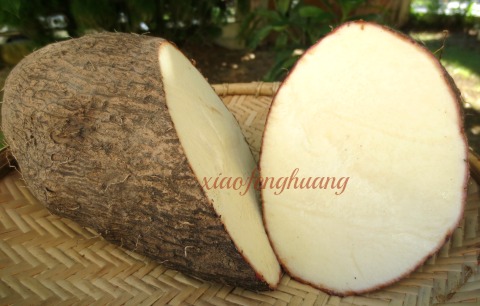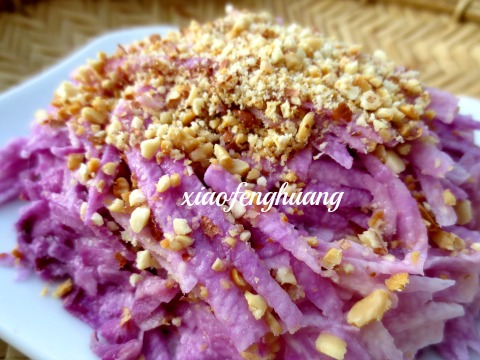Talking about tubers and root vegetabes, most people are familiar with taro and sweet potatoes but most people are not aware of the existence of some less common tubers like ubi badak/ubi jawa/ubi besar(Malay) or Obis(Bidayuh). Its ID is Diocorea Alata Linn.
It is known as Greater yam, water yam or winged yam in English. In Hakka it is called Tai Shu(大薯), simply means big potato but in Mandarin is called Mao shu/Shu yi(薯蓣)or fake shan yao/fake Chinese yam(伪山药).
There are two types of Ubi badak , ubi badak putih and ubi badak ungu. The picture above shows the yam which is bright lavender in color. Due to its attractive lavender color, Malay folks in Kelantan state like to make purple kueh like Koleh ubi badak, belebat ubi badak or purple cake out of this variety. Personally I prefer to make purple ondeh-ondeh ( glutinious rice balls, nyonya style) from this yam.
My late mom cooked soup with it. She would just scoop the flesh out with a spoon and added it to a pot of boiling water. Other ingredients include anchovies, pepper powder, salt and Chinese celery. For vegetarian version, just add mushroom powder to the ubi badak soup or porridge. Ubi badak cooks faster than taro so it is good choice for soup. This is one of the food that reminds me of my late mom’s cooking, so simple and yet so delicious. Yes, definitely no other food could beat food of love.

As for the white ubi badak, our old folks would just roast them on burning charcoal. It has thick skin like the tapioca but its flesh is much softer and without hard fibre. I prefer to eat it raw, like the way we eat sengkuang, the yam bean or sweet turnip(pachyrhizus erosus). Ubi badak has a texture like sengkuang but it is slimy. Both white and purple ubi badak can be eaten raw.

The picture above shows ubi badak putih in kerabu(malaysian salad). Pineapple was added instead of mango. The red dry fruits are wolfberries or goji (Lysium chinense) which can be replaced by raisins.
Or if you like, you can just steam it with the skin and peel off the skin after it is cooked. Ubi badak is not like other type of yam and taro which must be cooked before consumed. Most yam and taro contain plant toxins like dioscorin, diosgenin and tri-terpenes that cause itchiness on tongues when eaten raw. We have been eating this type of yam for decades, never once get itchy tongues.
We Malaysians call taro as yam but botanically they are two different plants. Yam is a tuber from a climber and taro is a root vegetable which is a perennial plant with big leaves. Ubi badak is a woody climber with pointed heart shaped leaves and square stems, thus the name winged yam. It propagates by its aerial tubers or a cut segment of the tuber.
It resembles in a lot of ways like the Chinese yam which has ID as Dioscorea polystachya or Dioscorea opposita. In fact, in some part of China,it is called fake Chinese yam(wei shan yao). Both have white and purple varieties and taste slimy. The only difference is in the appearance. Ubi badak can be massive if it is harvested at maturity. If left to grow in loose soil, it will have a long tuber shape but irregular shape shown if left to grow in harder soil.

For its nutritional values, please check it out from a site called ‘1 drop 1 dream’.
According to ayurvedic medicine, it is a cure for whip spider poison.
According to Chinese medicine, it acts as a remedy for piles and is applied externally to sores.
As an herbal treatment, Chinese yam in its dried form(wai shan-淮山) is used to target the stomach and spleen. It also thought to act on the lung and kidney. It is used widely in Chinese herbal soup and is beneficial to asthma, dry cough, chronic diarrhea and diabetics.
Since they are very similar, ubi badak must have similar health benefits as the Chinese yam. Yam is a good source of complex carbohydrates and soluble dieting fibre. It also help to reduce constipation, decrease bad (LDL) cholesterol level and get rid of toxic matters from intestine wall. This is especially true with ubi badak and Chinese yam which are both sticky and contain a lot of soluble fibre.
There is another type of yam called air potato(dioscorea bubifera linn) which grows wild in the rainforest of Borneo. I was told by some ex-guerrillas that they survived in the jungle by eating these air potatoes. Air potatoes have to be boiled to be edible. Most of the varieties of air potatoes are toxic but after boiling are edible and taste like potatoes. It is actually a Chinese herb used for treating cancer. It is known as Huang tu or huang yao zi(黄药子)in Chinese.
Copyright claim – Do not crop any pictures from malaysiavegetarianfood.com. Do not share our pictures without any watermarked signature on them. Excerpts from our articles to be credited to malaysiavegetarianfood.com.


